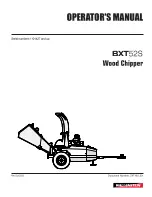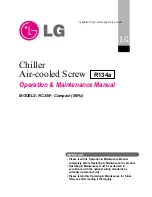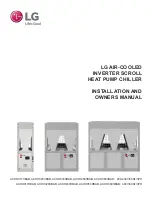
Operating Principles
74
CVHH-SVX001A-EN
m ore than four tim es in four hours, a latching diagnostic—
Purge Liquid Level Too High Continuously—w ill be
generated. The purge system w ill not restart until it is
reset.
If a Purge Liquid Level Too High Continuously diagnostic
occurs, check the purge lines for any type of restriction
(trapped liquid, closed valves, etc.) and ensure that the
filter-drier on the liquid return line is in good condition.
A UL-required pressure-relief device (fusible plug), w hich
protects against over-pressurization of the purge tank, is
m ounted on the purge tank. The plug m aterial w ill fuse at
98.9°C (210°F), w hich equates to approxim ately 910.1 kPag
(132 psig) for refrigerant R-1233
zd
(E).
Pump-out Subsystem
When the purge control subsystem detects the presence
of non-condensables in the purge tank, the pum p-out
solenoid and exhaust solenoid valves open, and the
pum p-out com pressor turns on. The valves and the
com pressor cycle on and off as needed to achieve an
efficient and fast rem oval of non-condensables.
A High Vacuum Pum p option is available for applications
that require purge operation at low condensing
tem peratures and pressures. This option provides a tw o-
stage pum p-out com pressor. The High Vacuum Pum p
option allow s the purge system to operate to saturation
tem peratures as low as 1.1°C (34°F). Typical applications
that m ay require the High Vacuum Pum p option include
free-cooling installations, series chiller installations, ice
system s having brine flow ing through idle chillers, chillers
installed outdoors or in unconditioned spaces, or any
application that m ay cause very low condenser water
tem peratures.
Carbon Tank and Regeneration Subsystem
The discharge from the pum p-out com pressor is piped
through the carbon tank. The special carbon in the tank
effectively scrubs and collects refrigerant m olecules from
the non-condensable gas before the gas passes through
the exhaust solenoid valve to the chiller vent line.
A 175 W resistive heater is m ounted inside the carbon tank
and is used to periodically “ regenerate” the carbon bed
and drive any collected refrigerant vapor back into the
chiller. A UL-required pressure-relief valve, rated at
1034.2 kPa (150 psi), is m ounted on the line leaving the
carbon tank. The valve protects against over-
pressurization of the carbon tank.
A tem perature sensor is installed through the top of the
carbon tank shell so that the controls can m onitor the
carbon bed tem perature. The tem perature sensor controls
the regeneration cycle and protect against overheating. If
the lim it tem perature is reached, the system shuts dow n
and a Purge Carbon Regen Tem perature Lim it Exceeded
diagnostic is generated.
Sensors
The follow ing sensors are used to enable control
com m unication betw een the Tracer UC800 controller and
the EarthWise purge system . The sensors use low-level
intelligence devices (LLIDs) to com m unicate w ith the
Tracer UC800 controller.
Compressor suction temperature sensor.
This
sensor is m ounted on the purge condensing unit suction
line. The controller uses the value of this tem perature
sensor to decide w hether or not to purge non-
condensables from the purge tank. When the tem perature
drops to a specified point, the controller activates the
pum p-out cycle to rem ove the accum ulated non-
condensables from the purge tank. When enough non-
condensables have been rem oved and the purge
com pressor suction tem perature increases in response,
the controller term inates the pum p-out cycle.
Saturated condenser temperature sensor.
This
sensor is m ounted on the chiller. If the chiller is running,
the controller uses the value of this tem perature sensor to
adjust the purge pum p-out initiate/term inate setpoints. It
m ay be used to prohibit pum p-out, if system conditions
are too cool.
Saturated evaporator temperature sensor.
This
sensor is m ounted on the chiller. If the chiller is Off, the
controller uses the value of this tem perature sensor to
adjust the purge pum p-out initiate/term inate setpoints. It
m ay be used to prohibit pum p-out, if system conditions
are too cool.
Carbon tank temperature sensor.
This sensor is
m ounted in the carbon tank of the purge system . It
provides feedback to the carbon regeneration algorithm .
The sensor and the controller function m uch the sam e as
a therm ostat to control the carbon tank heater.
Liquid level sensor.
This sensor resides in the purge
control panel. It m onitors the status of the norm ally closed
float sw itch, w hich is m ounted in the bottom of the purge
tank. If an adequate am ount of liquid fails to drain from the
purge tank, the float sw itch and sensor detect the
condition and prevent further purge operation.
Condensing unit LLID.
This LLID resides in the purge
control panel. It uses a high-capacity relay to control the
operation of the purge condensing unit.
Quad relay LLID.
This LLID resides in the purge control
panel. It has four relay outputs that are used to control the
pum p-out com pressor, the carbon tank heater, the
regeneration solenoid valve, and an alarm output.
Dual triac LLID.
This LLID resides in the purge control
panel. It has tw o triac-type outputs that are used to control
the pum p-out solenoid valve and the exhaust solenoid
valve. The purge system draw s its control pow er from the
pow er supplies of the chiller control panel.
Содержание CVHH
Страница 110: ......
















































